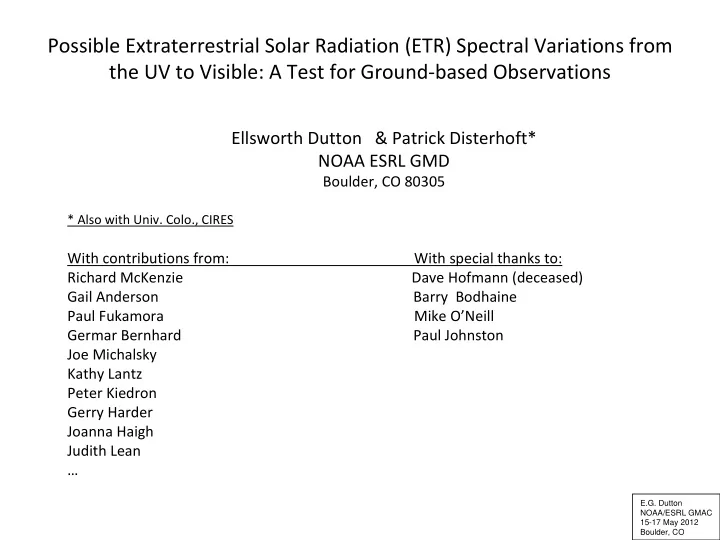

Possible Extraterrestrial Solar Radiation (ETR) Spectral Variations from the UV to Visible: A Test for Ground ‐ based Observations Ellsworth Dutton & Patrick Disterhoft* NOAA ESRL GMD Boulder, CO 80305 * Also with Univ. Colo., CIRES With contributions from: With special thanks to: Richard McKenzie Dave Hofmann (deceased) Gail Anderson Barry Bodhaine Paul Fukamora Mike O’Neill Germar Bernhard Paul Johnston Joe Michalsky Kathy Lantz Peter Kiedron Gerry Harder Joanna Haigh Judith Lean … E.G. Dutton NOAA/ESRL GMAC 15-17 May 2012 Boulder, CO
Possible Extraterrestrial Solar Radiation (ETR) Spectral Variations from the UV to Visible: A Test for Ground ‐ based Observations Outline • Motivation: Questions about recently ‐ suggested ETR spectral variations over the solar cycle and their climatic impact • Potential for surface ‐ based observations to contribute • GMD’s relevant(?) observations ‐ of ‐ opportunity • Preliminary comparisons of model ‐ , satellite ‐ and ground ‐ based relative solar spectra for periods of high vs. low solar activity • Path forward E.G. Dutton NOAA/ESRL GMAC 15-17 May 2012 Boulder, CO
Modeled and Satellite-Observed Changes in Spectral ETR Between an Active and Inactive Sun (Active, 2004 - Inactive, 2007) Avg. of 10 days Apr 2004 minus 10 days Nov 2007 From J. Haigh et al., 2010, Nature using: G. Harder et al., 2009, 2010 (SIM satellite) and J. Lean, 2000, 2010 (model) E.G. Dutton NOAA/ESRL GMAC 15-17 May 2012 Boulder, CO
Solar Spectra (ETR) E.G. Dutton NOAA/ESRL GMAC 15-17 May 2012 Boulder, CO
Looking through the UV/Vis window to the ETR E.G. Dutton NOAA/ESRL GMAC 15-17 May 2012 Boulder, CO
Looking through the UV/Vis window to the ETR Need clear sky conditions! E.G. Dutton NOAA/ESRL GMAC 15-17 May 2012 Boulder, CO
Modeled and Satellite-Observed Changes in Spectral ETR Between an Active and Inactive Sun UV/Vis Window J. Haigh et al., 2010 Apr 2004 - Nov 2007 Another Model for Active vs. Inactive ETR Spectra from J. Fontenla et al., 2011 as used in MODTRAN5 (Peak day minus Low day) Note: Not same days as Haigh et al. E.G. Dutton NOAA/ESRL GMAC 15-17 May 2012 Boulder, CO
GMD Spectral (UV/Vis) Solar Observations – Sites : Mauna Loa (MLO), Boulder (NIWA), and recently S. Pole, Palmer, and McMurdo, Antarctica (BSI) – all running since mid 1990s, NDACC contibutors – Originally intended for UV ‐ ozone atmospheric studies – For this talk – • MLO automated scanning double monochromator, NIWA (New Zealand) • 295 nm to 450 nm, 0.8 slit wdth, samp. at 0.2 nm, accuracy 0.03 nm • Total horizontal (all ‐ sky flux) radiation measured • Routine internal and external lamp calibrations performed • Data processing at GMD/Boulder and NIWA • Daily data since 1996 ‐ clear early mornings – 50% (See poster by Patrick Disterhoft for more info.) E.G. Dutton NOAA/ESRL GMAC 15-17 May 2012 Boulder, CO
E.G. Dutton NOAA/ESRL GMAC 15-17 May 2012 Boulder, CO
E.G. Dutton NOAA/ESRL GMAC 15-17 May 2012 Boulder, CO
MODTRAN Peak –Low day E.G. Dutton NOAA/ESRL GMAC 15-17 May 2012 Boulder, CO
E.G. Dutton NOAA/ESRL GMAC 15-17 May 2012 Boulder, CO
E.G. Dutton NOAA/ESRL GMAC 15-17 May 2012 Boulder, CO
E.G. Dutton NOAA/ESRL GMAC 15-17 May 2012 Boulder, CO
Conclusions • Many narrow bandwidth ( ≈ 2 nm) features of spectral changes over the solar ‐ cycle suggested by the Fontenla model appear to be captured in the MLO surface data. • The MLO data also capture the main larger (4 ‐ 10 nm) spectral features apparent in all data sets, but different amplitudes, in the 365 ‐ 415 nm region. • MLO obs. suggest higher amplitude variations in the 4 ‐ 10 nm ‐ wide features than the Lean model. However, further addressing SIM satellite vs. model issues at this time is not warranted. • Surface data warrant further application to this topic. Refinements should include: atmos. correction (to extend spectral range to near 305 nm), use of higher available precision, closer date matching, consider time evolution of features, convolve spectra to the same resolution, and further specific review of surface obs. relative to this new application... E.G. Dutton NOAA/ESRL GMAC 15-17 May 2012 Boulder, CO
END
MODTRA RAN P Peak ak da days
Modeled and Observed Changes in Spectral ETR Between an Active and Inactive Sun J. Haigh et al., 2010 Apr 2004 minus Nov 2007 Model from J. Fontenla et al. 2011 as used in MODTRAN5 (Peak day minus Low day ETR spectra) Note: Not same dates as used by Haigh et al.
Recommend
More recommend